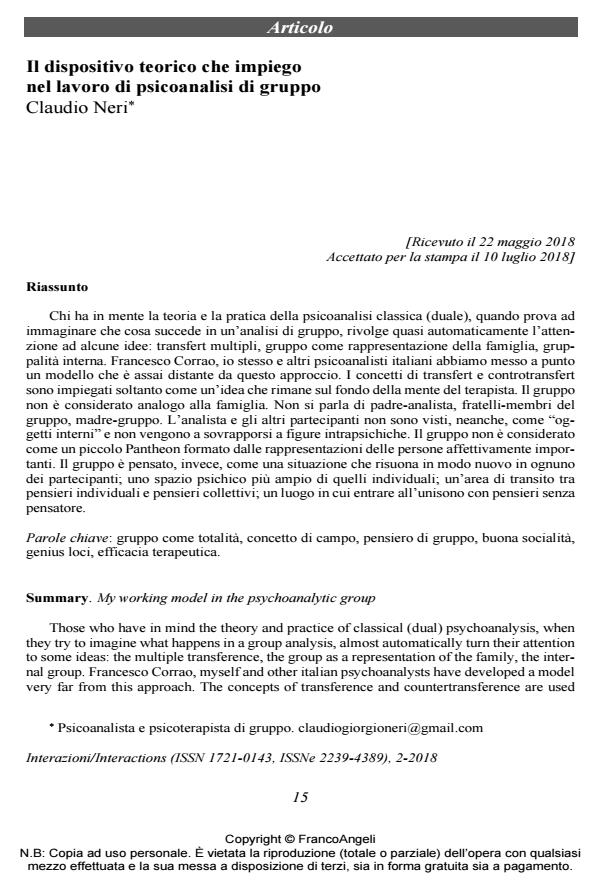My working model in the psychoanalytic group
Journal title INTERAZIONI
Author/s Claudio Neri
Publishing Year 2018 Issue 2018/2 Language Italian
Pages 9 P. 15-23 File size 155 KB
DOI 10.3280/INT2018-002002
DOI is like a bar code for intellectual property: to have more infomation
click here
Below, you can see the article first page
If you want to buy this article in PDF format, you can do it, following the instructions to buy download credits

FrancoAngeli is member of Publishers International Linking Association, Inc (PILA), a not-for-profit association which run the CrossRef service enabling links to and from online scholarly content.
Those who have in mind the theory and practice of classical (dual) psychoanalysis, when they try to imagine what happens in a group analysis, almost automatically turn their attention to some ideas: the multiple transference, the group as a representation of the family, the internal group. Francesco Corrao, myself and other italian psychoanalysts have developed a model very far from this approach. The concepts of transference and countertransference are used only as an idea that remains in the background. The group is not considered analogous to the family. The therapist does not speak of a father-analyst, brothers-members of the group, mother-group. The analyst and the other participants are not even seen as "internal objects" and do not overlap with intrapsychic figures. The group is not considered a small Pantheon composed of representations of the most important people in childhood. Instead, the group is thought of as a situation that resounds in a new way in each of the participants; a psychic space wider than the individual ones; an area of transit between individual thoughts and collective thoughts; a place where you could enter in unison with thoughts without a thinker.
Keywords: Group as a whole, the field, group thinking, genius loci, good sociability, thera-peutic efficacy.
- Bion W.R. (1961). Experiences in Groups. London: Tavistock Publications (trad. it. Esperienze nei gruppi. Roma: Armando, 1971).
- BCPSG ‒ The Boston Change Process Study Group (2010). Change in Psychotherapy: A Unifying Paradigm. New York: Norton (trad. it. Il cambiamento in psicoterapia. Milano: Raffaello Cortina, 2012).
- Cruciani P., Neri C. (2009). Sur la naissance de la psychothérapie de groupe en Italie. Revue de Psychothérapie Psichanalutique de Groupe, 52, 1: 45-59.
- De Maré P., Piper R., Thompson S. (Eds.) (1991). Koinonia: From Hate, through Dialogue, to Culture in the Larger Group. Koinonia. London: Karnac (trad. it. Dall’odio, attraverso il dialogo, alla cultura nel grande gruppo. Roma: Edizioni Universitarie Romane, 1996).
- Foulkes S.H. (1964). Therapeutic Group Analysis. London: George Allen & Unwin Ltd (trad. it. Analisi terapeutica di gruppo. Torino: Boringhieri, 1967).
- Lewin K. (1948). Resolving social conflicts: selected papers on group dynamics. New York: Harper & Row (trad. it. I conflitti sociali: saggi di dinamica di gruppo. Milano: FrancoAngeli, 1976).
- Neri C. (1988). Champ de l’experience groupal: un homologue ou un analogue du trasfert dans la situation de la cure? Revue de Psychoterapie Psychanalytique de Groupe, 12, 1: 21-33.
- Neri C. (2017). Gruppo. Milano: Raffaello Cortina.
- Nissim Momigliano L. (2008). Ricordi della casa dei morti e altri scritti. Firenze: Casa Editrice Giuntina.
Claudio Neri, Il dispositivo teorico che impiego nel lavoro di psicoanalisi di gruppo in "INTERAZIONI" 2/2018, pp 15-23, DOI: 10.3280/INT2018-002002